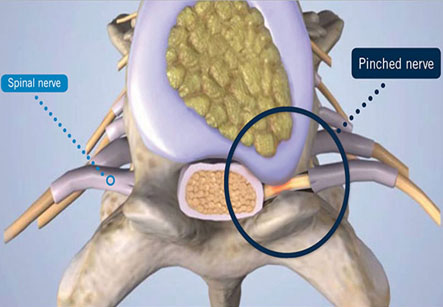Pinched Nerve
Introduction
Nerves extend from the brain and spinal cord and send important messages throughout the body. The pinched nerve is also called as compressed nerve.
Damage to a pinched nerve may be minor or severe. It may cause temporary or long-lasting motor, sensory or autonomic problems. The earlier the diagnosis and treatment of nerve compression, the more quickly the patient can be relieved of symptoms.
In some cases, the damage from a pinched nerve cannot be reversed. But treatment usually relieves pain and other symptoms.
Causes of Pinched Nerves:
A pinched nerve occurs when there is “compression” or pressure on a nerve. The pressure may be the result of repetitive motions or it may happen from holding the body in one position for long periods, such as keeping elbows bent while sleeping.
We have all the information you need about public and private clinics and hospitals that provide spinal surgery in Iran, Islamic Republic Of with the best quality and lowest possible prices

Nerves are most vulnerable at places in the body where they travel through narrow spaces but there is little soft tissue to protect them. Nerve compression often occurs when the nerve is pressed against the tissues such as:
1. Ligament
2. Tendon
3. Bone
Some commonly compressed or “pinched” nerves include:
1. Median nerve (affects sensations in the hand)
2. Ulnar nerve (extends down the arm past the elbow)
3. Radial nerve (also extends down the arm)
4. Femoral nerve (extends from the hip to the knee)
5. Plantar nerves (located in the feet)
6. Tibial nerve (over the knee and lower leg)
7. Nerves exiting from each of the spinal bones
8. Peroneal nerve (runs along the side of the leg)
9. Sciatic nerve (located in the back of the thigh)
Symptoms of Pinched Nerves:
The pinched nerve causes pain. For instance, inflammation or pressure on a nerve root exiting the spine may cause neck or low back pain. The pain radiates or projects along the course of the pinched nerve. Pain can radiate along the neck into the shoulder and arm (cervical radiculopathy) or it may radiate into the leg and foot (sciatica). These symptoms may be caused by damage to the spine’s discs and bones. For example, if a disc weakens or tears away (herniated disc), it puts pressure on a spinal nerve.
Nerve compression in the neck or arm may also cause symptoms in areas such as elbow, hands, wrist and fingers. This can result in condition like peripheral neuropathy, carpal tunnel syndrome or tennis elbow.
If nerve compression lasts a long time, a protective barrier around the nerve may break down. Fluid may build up and swelling can occur. This can cause extra pressure, scarring and loss of the nerve’s function.
Sometimes, there may be other symptoms without pain.
1. Numbness or tingling
2. Pins and needles sensation or a burning sensation
3. Weakness, especially with certain activities
Sometimes symptoms worsen while trying certain movements, such as turning the head or straining the neck.
Treatment for Pinched Nerves
The period for recovery from symptoms varies from person to person. Treatment also varies, depending upon the severity and cause of the nerve compression.
Nerve compression in the neck or arm may also cause symptoms in areas such as elbow, hands, wrist and fingers.
The patient may find a great benefit from simply resting the affected or injured area and also by avoiding any activities that tend to worsen the symptoms. In many cases, this is all you need to do.
If the symptoms persist or pain is severe, seek medical help. One or more types of treatment may be required to shrink swollen tissue around the nerve.
In more severe cases, it may be necessary to remove material that is pressing on a nerve, such as scar tissue, disc material or pieces of bone.
Treatment may include:
• NSAIDs -Nonsteroidal anti-inflammatory drugs (NSAIDs) such as aspirin or ibuprofen may reduce the swelling around the nerve.
• Oral corticosteroids. These are also used to reduce swelling and pain.
• Narcotics. These can be used for brief periods under medical supervision to reduce severe pain.
• Steroid injections. These injections may reduce swelling and allow the inflamed nerves to recover.
• Physical therapy. This will help to stretch and strengthen muscles.
• Splint. A splint or soft collar can be used for limiting the motion of the affected part and allows the muscles to rest for brief periods.
• Surgery. Surgery may be needed as a last resort for more severe problems that do not respond to other types of treatment